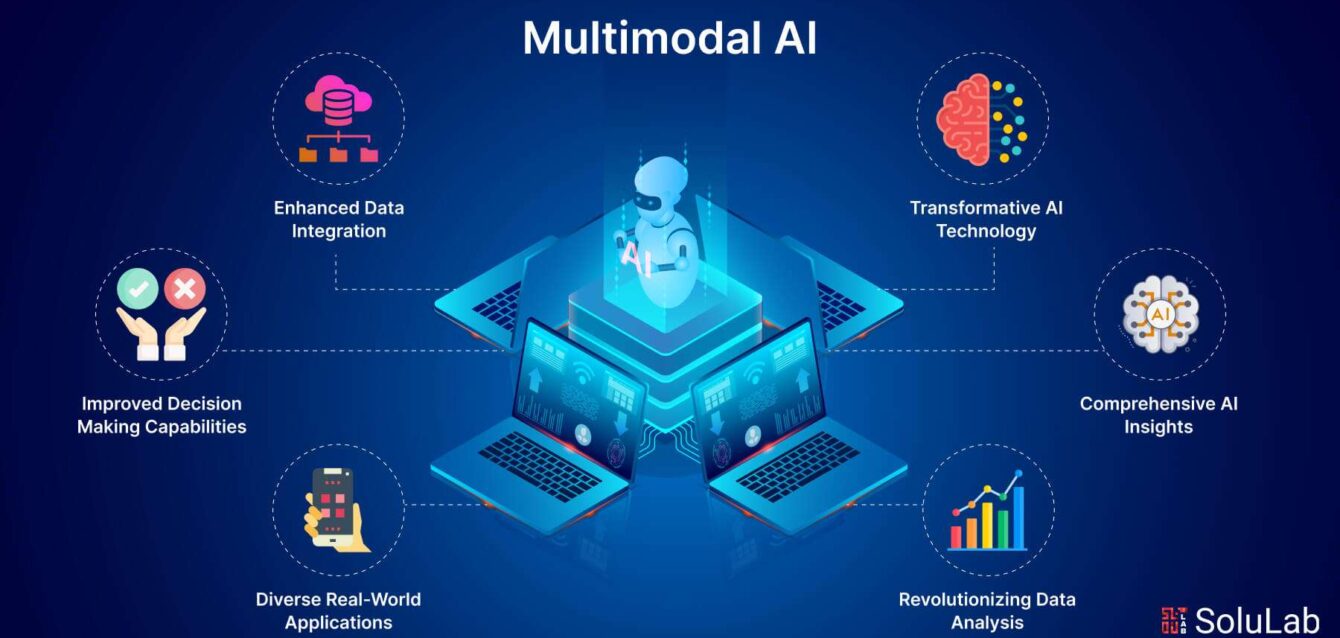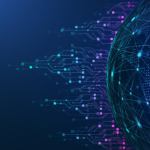Late 2023: AI Evolves – Multimodal, Integrated, and Enterprise-Ready
Discover how AI’s evolution is transforming business workflows and powering innovation.
Introduction
Introduction:
By the latter half of 2023, one thing was clear: AI wasn’t slowing down. In fact, it was evolving in new directions. The buzzwords of this era? Multimodal, integration, and enterprise. After GPT-4’s launch, the focus shifted to making AI more versatile (able to see, hear, and act) and more deeply embedded in business workflows. If early 2023 was about who had the smartest model, late 2023 was about what you could actually do with these models in real-world scenarios. From OpenAI giving ChatGPT eyes and ears (yes, literal image recognition and voice conversation!) to a wave of AI-powered business tools, the end of 2023 felt like we were living in Tony Stark’s lab – with AI assistants not just chatting, but observing and creating. Let’s dive into how AI became multimodal, the rise of AI in enterprise software, and the massive partnerships that formed to fuel this new phase of AI adoption.
ChatGPT Can See and Speak
ChatGPT Can See and Speak:
Perhaps the most jaw-dropping demo of late 2023 was when ChatGPT gained vision and voice. OpenAI rolled out updates enabling ChatGPT to accept image inputs and generate spoken responses.
openai.com. Suddenly, you could snap a photo of a broken appliance and ask ChatGPT how to fix it, or show it a chart and have it explain the data. This was a game-changer. For instance, a user could upload a photo of a hand-drawn wireframe and ChatGPT (powered by GPT-4 with vision) could generate HTML/CSS code for that design – essentially reading visuals and turning them into action. In another use case, doctors experimented with showing rashes or X-rays to GPT-4 for preliminary analysis (with all appropriate caveats, of course).
On the voice side, OpenAI introduced speech capabilities so you could talk to ChatGPT and it would talk back in a realistic human-like voice.
openai.com. Five distinct voices were offered, developed in collaboration with professional voice actors. It felt like having a phone call with an AI that remembered everything from the web it had read. For business users, this opened up possibilities for AI in hands-free scenarios – think field technicians troubleshooting machinery by speaking with an AI assistant, or executives getting an AI briefing through their smart earbuds during a commute. It also made AI more accessible, bridging literacy and language gaps; people could interact with AI in the mode they found most natural. Multimodality (combining text, images, and audio) was no longer just a research concept – it became a deployed feature that added a whole new dimension to how businesses could leverage AI. An AI that can see a graph or listen to a client’s tone of voice offers richer assistance than one that only processes text.
Plugin Ecosystem and Tool Use
Plugin Ecosystem and Tool Use:
Around the same time, OpenAI and others tackled a crucial challenge: how to make AI useful beyond chat by having it interact with external systems. Enter plugins and tool integrations. Earlier in 2023, OpenAI launched ChatGPT Plugins, turning ChatGPT into a platform that can call on third-party services.
searchenginejournal.com. Imagine ChatGPT being able to pull real-time stock prices, book a meeting on your calendar, or query your company database – that’s what plugins enabled. Initial plugins included a web browser, a code interpreter, and connectors to popular services (Expedia for travel info, Zapier for workflows, etc.).
searchenginejournal.com. By late 2023, this ecosystem expanded massively. Need to analyze marketing data? There’s a plugin for that. Want ChatGPT to draft a contract using your company’s template from Google Drive? There’s a plugin for that too.
Perhaps the most significant built-in tool was the Code Interpreter, which essentially gave ChatGPT a calculator, a data analyzer, and a Python coder in its toolkit.
searchenginejournal.com. Users could upload files (CSV, JSON, images) and ChatGPT would write code behind the scenes to process them – producing results like “your data’s top 5 trends are X, here’s a graph”. This turned ChatGPT into a mini data scientist for hire. For businesses, it meant even complex tasks (data cleaning, visualization, optimization problems) could be handled in a conversational workflow. No need to switch to a separate IDE or spreadsheet – you just ask ChatGPT and it figures out the technical heavy lifting. The ROI from this can be huge: Analysts save hours, non-technical team members get empowered to extract insights themselves, and organizations make faster data‑driven decisions.
OpenAI wasn’t alone here. Other models also gained “tool use” abilities via APIs. For example, Microsoft introduced an “Assistants API” at their November OpenAI DevDay that allowed developers to create AI agents with defined tools (like a CRM database lookup or a SAP integration).
openai.com. This meant a company could have a custom GPT-4 that, if asked about inventory levels or last quarter’s sales, would call the internal database and then formulate an answer – all seamlessly in one chat. We began moving from generic AI models to specialized AI agents that can act on behalf of users in specific domains. Late 2023 gave us the first taste of what’s often depicted in sci‑fi: asking your AI to “handle this task” and it going off to interact with various systems to get it done.
AI in Enterprise Software – From Power BI to Salesforce
AI in Enterprise Software – From Power BI to Salesforce:
As AI proved its value, major enterprise software providers rushed to integrate AI natively into their platforms. After all, why leave it to users to copy‑paste between ChatGPT and their work apps when AI could live inside those apps? Here are some notable shifts:
- Microsoft’s Suite (Teams, Office, Power Platform): Microsoft’s investment in OpenAI paid dividends as they swiftly rolled out AI features across Microsoft 365. By late 2023, Outlook could summarize long email threads, Word could compose drafts from prompts, and Excel could generate formulas or even entire dashboards from natural language questions. Microsoft Teams introduced an intelligent recap feature – miss a meeting and the AI would generate a summary and highlight who said what. Perhaps most interesting for data‑driven orgs, Power BI’s AI (through Azure OpenAI) allowed conversational data exploration. A manager could ask in plain English, “What were our top 5 products by revenue last month and how did that compare to the previous month?” and get a neatly generated chart with an explanation. This kind of AI-powered dashboard development meant decision-makers spent less time wrangling with UI filters and more time interpreting results.
- CRM and Customer Experience: Salesforce, the king of CRM, wasn’t going to be left behind. They announced Einstein GPT in 2023, injecting AI assistants into their Sales Cloud and Service Cloud. A sales rep could get AI-generated personalized messages to send to a prospect, pulled together from Salesforce data and GPT’s knowledge of writing tone. Support agents got AI suggestions for resolving cases, complete with knowledge base article links. And marketers using Salesforce’s tools could auto-generate segments or campaign content ideas. The result across the board was a boost in productivity and consistency – AI could draft the first version of virtually any business communication, and the human just edits and approves.
- Custom Internal Tools: Beyond off‑the‑shelf software, many enterprises built custom AI‑powered dashboards and tools tailored to their needs. For example, a logistics company created a control center dashboard where an AI agent would flag anomalies in shipping data and suggest actions (like “Route X is delayed due to weather, consider re‑routing via Y”). They did this by feeding real‑time data to an internal GPT-4 model with domain training. Another firm integrated an AI into its ERP system; employees could ask, “What’s our current raw material inventory and when will it run out at current consumption?” and the AI would pull numbers from SAP and answer in seconds. These bespoke solutions delivered huge efficiency gains and were often built in weeks, whereas a traditional software feature might take months. The key was having the right expertise – teams or consultants who understood both the business process and how to weave in an AI component. This is exactly where AI consulting proved its worth: bridging the gap between what the technology could do and what the business needed.
Big Bets and Partnerships
Big Bets and Partnerships:
Late 2023 wasn’t just about flashy demos; it was also about laying groundwork. Some truly massive partnerships and investments were announced, signaling that AI is now a core long‑term play for many industries:
- OpenAI & Partners – The $500B Stargate Project: Perhaps the boldest move came right at the start of 2024 (okay, we’ll count it as part of the late‑2023 momentum). OpenAI announced Project Stargate – a new venture intending to invest $500 billion over four years to build out AI supercomputing infrastructure. openai.com. Yes, billion with a B. Key funders include SoftBank, Oracle, and even former OpenAI rivals. The goal? To ensure the U.S. leads in AI by massively scaling compute power for model training and deployment. This was a response to the insatiable appetite for AI capabilities that 2023 demonstrated. For businesses, this is a positive sign: the cloud backbone powering AI services is going to get much stronger, meaning more reliable and powerful AI solutions for you in the coming years. It’s like the highway system being built for the AI economy – expect faster and bigger “vehicles” (models) cruising along soon.
- Microsoft, Google, Amazon – Cloud Wars Evolve: All the cloud giants doubled down on AI. Microsoft, beyond its OpenAI stake, started offering Azure AI Services that bundle models with enterprise features (compliance, security) – by Nov 2023 they had thousands of Azure AI customers and even special Azure hardware for GPT-4. Google, not to be outdone, integrated its AI (PaLM 2 and soon Gemini) into Google Cloud offerings, so clients could use them via the Vertex AI platform. Google also invested $300M in Anthropic (Claude’s creator) back in February 2023 for a roughly 10% stake, and there’s talk of increasing that investment – a sign that even competitors are hedging bets by partnering with multiple AI labs. Amazon made a splash by investing $4B in Anthropic and tying them into AWS as a primary cloud provider. aboutamazon.com. By early 2024, Anthropic’s latest models (Claude 2 and Claude 3) were available on Amazon Bedrock, AWS’s AI model marketplace. For businesses, these cloud + AI tie‑ups mean easier access to a variety of AI models. Whatever cloud you’re on, there’s a smorgasbord of AI services available – and vendors are competing on who can offer the better, cheaper, more fine‑tuned model. This competition benefits customers through lower costs and more innovation.
- Industry-Specific AI Alliances: We also saw sector‑focused AI partnerships. For example, several medical research institutes and tech firms formed consortia to build AI for drug discovery (using GPT‑style models on chemical data). Banks and financial giants, concerned with data security, collaborated on private AI models that could handle financial reports and forecasts without data ever leaving their secure environment. And the auto industry joined the fray: a notable partnership between Tesla, Toyota, and others kicked off to use generative AI for autonomous vehicle decision‑making and in‑car assistants. These moves, while not front‑page news like ChatGPT, illustrate that every industry is injecting AI into its DNA, often through partnerships to pool expertise and resources.
SEO and Business Lens
SEO and Business Lens:
From a business perspective, the late 2023 trend was about operationalizing AI. Searches for terms like “AI integration services,” “enterprise AI solutions,” and “AI dashboard development for [X] industry” all ticked upward. It’s one thing to have AI in a lab; it’s another to have it running reliably in a production environment. That’s why many companies turned to AI consulting firms to help integrate models into their existing IT stack. Concerns like data privacy, compliance (think GDPR with AI-generated content), and scaling had to be addressed. Our firm, for example, worked with a client to integrate an AI tool within their on-premise environment because their policy forbade sending data to external clouds. We used open‑source models fine‑tuned on their data – a custom solution that ticked all their boxes. It’s a reminder that while the flashy AI capabilities grab headlines, the behind‑the‑scenes engineering and strategy are what make it truly useful for a business.
If you’re reading about these developments and thinking, “This sounds great, but how do we actually do that at our company?” – you’re not alone. That’s exactly the question thousands of business leaders started asking in late 2023. They saw competitors launching AI‑powered features and employees advocating for AI tools to reduce drudgery. The smart move is to bring in experts who live and breathe this technology to help craft a roadmap. Custom AI solutions for businesses don’t come in a one‑size‑fits‑all box; they need to be tailored, much like a suit. You want the right model, the right integration, and the right user experience for your users. And importantly, you want it to align with your business objectives (be it increasing revenue, cutting costs, or improving customer satisfaction).
Conclusion & Call to Action
Conclusion:
As 2023 drew to a close, AI had firmly entrenched itself in the business world. It could see, talk, crunch data, and plug into our apps – a far cry from the simple Q&A bots of yesteryear. Multimodal AI and seamless integrations have made it possible to have an AI at every proverbial “meeting table” in your company, contributing where relevant. The partnerships and infrastructure investments underway mean this technology will only become more robust and ubiquitous in 2024 and beyond.
So, what’s your move? The companies that leapt on these trends are now reaping rewards: faster insights, happier customers, and innovative new services that differentiate them in the market. If you haven’t started, you might feel like you’re behind – but there’s a way to catch up fast (and even leapfrog others): partner with those who have done it before. This is where our AI consulting and development services come in. We help businesses like yours take these AI advances – from multimodal GPT-4 to custom plugins and integrations – and apply them to your unique challenges and goals.
Do you need an AI-powered dashboard that turns your data deluge into actionable visuals and summaries? Or perhaps a conversational assistant that can handle customer inquiries across text, voice, and even images? Maybe it’s about streamlining internal processes with an AI that knows your legacy systems. Whatever the case, we’ll work with you to design and implement a solution that delivers tangible ROI. We’ll handle the nitty‑gritty of model selection, API orchestration, and training – you’ll see the results.
Don’t get left behind in the AI integration wave. Every day your team spends copy‑pasting between systems or manually sifting data is a day competitors with AI are moving faster. Instead, empower them with custom AI tools and watch productivity and creativity soar. Contact us for a consultation on how custom AI solutions and dashboards can be woven into the fabric of your business. We’re passionate about turning these cutting‑edge advancements into day‑to‑day value for you – let’s build the future of your business together.
Stay tuned for the final installment of our AI milestone series: we’ll explore 2024 up to early 2025, including global AI competition, regulatory developments, and how the stage set in 2023 leads to the AI‑driven business landscape of tomorrow.





